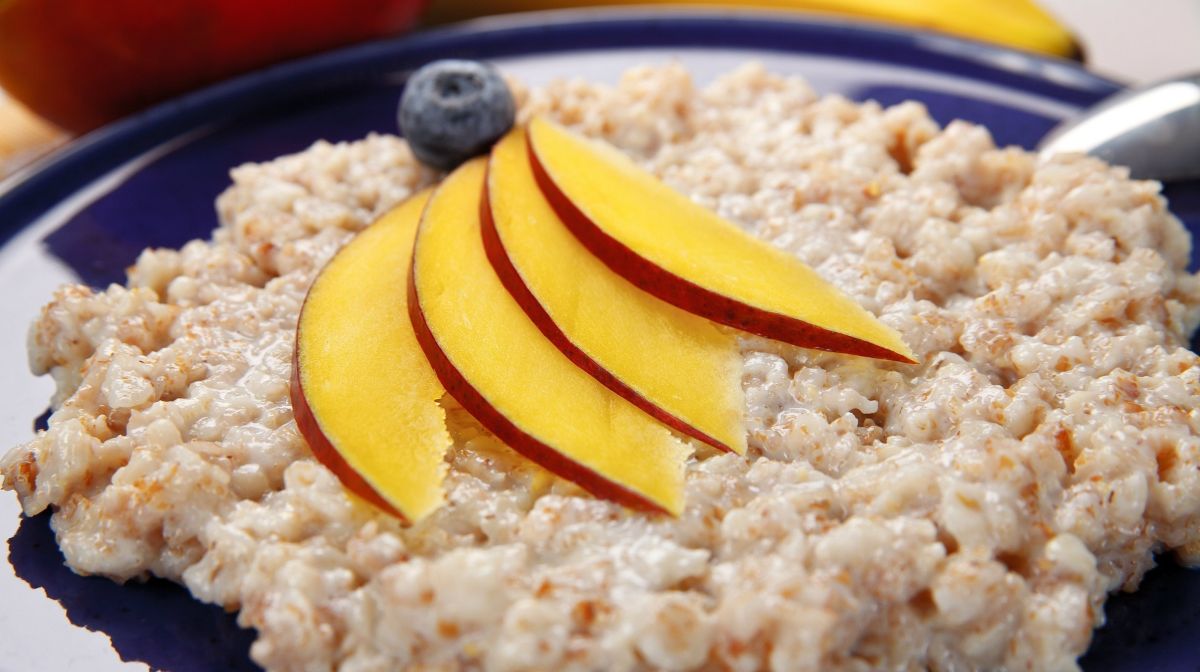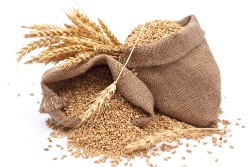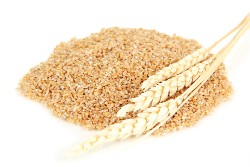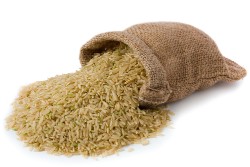What is useful for wheat porridge — 6 proven properties
In ancient Russia, wheat groats were one of the main products in the diet. It is still an important component of a healthy diet and an ingredient for many dishes, the most popular of which is porridge.
Wheat porridge is made exclusively from durum wheat and is famous for its abundance of nutrients and health benefits. Modern scientists claim that it improves the functioning of many organs and reduces the risk of developing the most common diseases.
Content
How it is useful – 6 facts
Below are the 6 main beneficial properties of wheat porridge (based on evidence).
1. It has a rich composition

The main ingredient of porridge is wheat groats. It has a high energy value (about 327 calories per 100 grams) and contains mass of biologically active components:
| Name of the substance | Percentage of the recommended daily requirement (per 100 grams) |
| proteins | 15 % |
| dietary fiber | 23 % |
| Vitamin B1 | 20 % |
| Vitamin B5 | 18 % |
| Vitamin E | 11 % |
| Nicotinic acid | 14 % |
| potassium | 9 % |
| magnesium | 15 % |
| phosphorus | 35 % |
| iron | 26 % |
| selenium | 129 % |
| Omega-3 fatty acids | 8 % |
Wheat grains are a unique source of vitamins and minerals for the human body. Their content varies slightly depending on the soil on which the plant was grown.
It also contains a number of unique plant antioxidants:
- Ferulic acid;
- Phytic;
- Alkylresorcins;
- Lignans;
- Agglutinin;
- Lutein.
These substances inhibit chronic inflammation, support metabolism and reduce the risk of developing malignant tumors in the body (mainly from the large intestine).
2. Improves bowel function
 Wheat rich in fiber
, which has a number of medicinal properties:
Wheat rich in fiber
, which has a number of medicinal properties:
- Normalizes the composition of the microflora. Part of the fiber (insoluble fibers) reaches the distal parts of the intestine unchanged, where serves as food for friendly microorganisms. As a result, the number of beneficial bacteria increases, the growth and reproduction of pathogenic representatives of the microflora is inhibited.
- Improves bowel movement. Dietary Fiber strengthen motor activity of the smooth muscles of the intestinal wall, preventing the retention of feces and the development of constipation.
- Reducing the risk of developing diseases. Due to adequate peristalsis, stagnation of fecal masses is prevented, local immunity increases. As a result, infectious and inflammatory diseases are less often diagnosed.
3. Provides prevention of colon cancer
 Colon cancer is the most common tumor of the gastrointestinal tract.
Colon cancer is the most common tumor of the gastrointestinal tract.
Numerous studies American and British experts demonstrate that regular consumption of whole wheat is associated with a low incidence of colon and rectal cancer.
Fiber is food for friendly bacteria. During the fermentation of fibers by microorganisms, a special substance is formed – butyrate, which improves the metabolism in colonocytes, preventing their malignant transformation.
Additional protective property possess antioxidants, which wheat contains in large quantities.
4. Improves thyroid health
 Specialists from the University of Surrey (UK) claim
that selenium, which is found in large quantities in wheat, protects the thyroid gland from many diseases.
Specialists from the University of Surrey (UK) claim
that selenium, which is found in large quantities in wheat, protects the thyroid gland from many diseases.
The mineral corrects the production of thyroid hormones, reduces the risk of developing malignant and benign tumors of this organ several times.
Selenium is also effective in preventing autoimmune lesions of the gland (for example, diffuse toxic goiter).
5. Helps to lose weight
 Wheat is rich in dietary fiber, which promote weight loss
.
Wheat is rich in dietary fiber, which promote weight loss
.
After ingestion, fiber increases significantly in size and causes mechanical overflow of the stomach. This leads to the suppression of hunger centers in the brain and a decrease in appetite for several hours.
Inclusion of sufficient amounts of fiber in the menu, such as claim Canadian scientists, lies at the heart of maintaining body weight.
A special role is also given to proteins, which are present in large quantities in wheat. They change the hormonal background and suppress appetite, contributing to even greater weight loss.
6. Supports the health of the cardiovascular system
 American scientists proved
that any diet rich in dietary fiber reduces the likelihood of developing heart and vascular diseases by 24%.
American scientists proved
that any diet rich in dietary fiber reduces the likelihood of developing heart and vascular diseases by 24%.
Fiber, for information of the scientific community, normalizes lipid profile indicators, lowering the level of total cholesterol and LDL. As a result, conditions are not created for the formation of atherosclerotic plaques on the walls of arteries, leading to their complete or partial obstruction.
Against this background, pathologies such as coronary heart disease, stroke, and myocardial infarction are much less common.
Wheat groats are also rich in magnesium, potassium and antioxidants. These substances reduce blood pressure and protect the walls of blood vessels from fibrous transformation during hypertension. Such medicinal properties of the plant are especially important for the elderly.
Possible harm
 Of course, wheat is a healthy and nutritious product. However, even it has contraindications, and in some cases it can cause harm to health. The most common side effects include:
Of course, wheat is a healthy and nutritious product. However, even it has contraindications, and in some cases it can cause harm to health. The most common side effects include:
- Reduced absorption of nutrients. Whole wheat contains a large amount of phytic acid. Being a valuable antioxidant, it inhibits the absorption of iron and zinc in the lumen of the gastrointestinal tract.
- Dyspeptic disorders. With excessive inclusion of wheat porridge in the intestine, fermentation and putrefaction processes are activated, which can lead to diarrhea, bloating, increased gas formation.
- Allergic reactions. Increased sensitization of the body to gluten and other wheat proteins is quite common. People with a history of allergies to the product are advised to refrain from using any substances containing wheat.
It is not recommended to consume wheat and products based on it (cereals) for pregnant women in late pregnancy. When breastfeeding, the product is allowed only after the child reaches the age of 4 months.
How to cook?
 The process of making wheat porridge is not difficult. It is allowed to cook wheat groats with milk or water. Both options are useful and can be safely included in the diet.
The process of making wheat porridge is not difficult. It is allowed to cook wheat groats with milk or water. Both options are useful and can be safely included in the diet.
For classic wheat porridge, you will need:
- 100 grams of wheat groats;
- 300 ml of water;
- 1 tsp sugar or salt.
Recipe:
- Rinse the cereal thoroughly under cold water.
- Pour water into an enameled saucepan. Immediately add the grits, as well as salt and sugar (to taste).
- Put on fire, bring to a boil and simmer for about 15 minutes.
- Turn off the heat and leave for 30-40 minutes under the lid (to infuse).
- The dish is ready.
It is allowed to add any dried fruits, vegetables, berries and fruits to the resulting porridge.
Plain wheat or spelt: which is healthier?
 About 200 years ago, there was only one variety of wheat. In the following time, Western breeders brought out a fundamentally new variety – spelt. It differs from classic wheat (spelt) not only in appearance, but also in organoleptic characteristics.
About 200 years ago, there was only one variety of wheat. In the following time, Western breeders brought out a fundamentally new variety – spelt. It differs from classic wheat (spelt) not only in appearance, but also in organoleptic characteristics.
The new wheat variety quickly spread around the world and gained recognition among nutritionists.
Although spelt contains many nutrients necessary for humans, it is inferior to classic wheat in terms of iron, proteins and B vitamins. The only positive feature of spelt is its low gluten content, which makes it possible to include it in the diet of people with celiac disease.
Conclusion
Thus, wheat porridge is a valuable natural food product. It combines many vitamins, minerals and antioxidants in its composition, and is also rich in fiber.
When systematically included in the diet, wheat has a beneficial effect on body weight, improves intestinal function, prevents the development of many diseases from the cardiovascular, digestive and endocrine systems.





